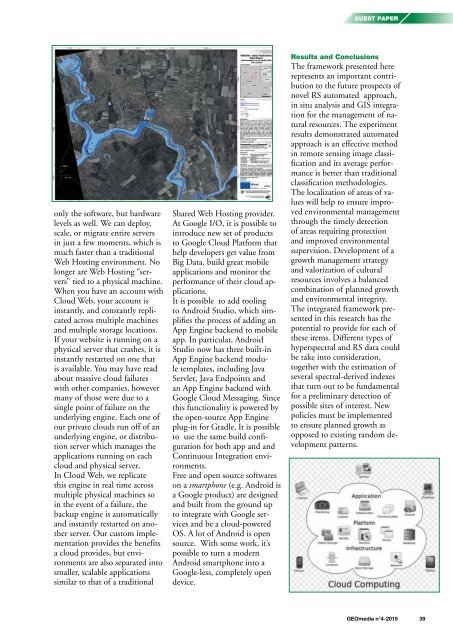Create successful ePaper yourself
Turn your PDF publications into a flip-book with our unique Google optimized e-Paper software.
GUEST PAPER<br />
only the software, but hardware<br />
levels as well. We can deploy,<br />
scale, or migrate entire servers<br />
in just a few moments, which is<br />
much faster than a traditional<br />
Web Hosting environment. No<br />
longer are Web Hosting “servers”<br />
tied to a physical machine.<br />
When you have an account with<br />
Cloud Web, your account is<br />
instantly, and constantly replicated<br />
across multiple machines<br />
and multiple storage locations.<br />
If your website is running on a<br />
physical server that crashes, it is<br />
instantly restarted on one that<br />
is available. You may have read<br />
about massive cloud failures<br />
with other companies, however<br />
many of those were due to a<br />
single point of failure on the<br />
underlying engine. Each one of<br />
our private clouds run off of an<br />
underlying engine, or distribution<br />
server which manages the<br />
applications running on each<br />
cloud and physical server.<br />
In Cloud Web, we replicate<br />
this engine in real time across<br />
multiple physical machines so<br />
in the event of a failure, the<br />
backup engine is automatically<br />
and instantly restarted on another<br />
server. Our custom implementation<br />
provides the benefits<br />
a cloud provides, but environments<br />
are also separated into<br />
smaller, scalable applications<br />
similar to that of a traditional<br />
Shared Web Hosting provider.<br />
At Google I/O, it is possible to<br />
introduce new set of products<br />
to Google Cloud Platform that<br />
help developers get value from<br />
Big Data, build great mobile<br />
applications and monitor the<br />
performance of their cloud applications.<br />
It is possible to add tooling<br />
to Android Studio, which simplifies<br />
the process of adding an<br />
App Engine backend to mobile<br />
app. In particular, Android<br />
Studio now has three built-in<br />
App Engine backend module<br />
templates, including Java<br />
Servlet, Java Endpoints and<br />
an App Engine backend with<br />
Google Cloud Messaging. Since<br />
this functionality is powered by<br />
the open-source App Engine<br />
plug-in for Gradle, It is possible<br />
to use the same build configuration<br />
for both app and and<br />
Continuous Integration environments.<br />
Free and open source softwares<br />
on a smartphone (e.g. Android is<br />
a Google product) are designed<br />
and built from the ground up<br />
to integrate with Google services<br />
and be a cloud-powered<br />
OS. A lot of Android is open<br />
source. With some work, it’s<br />
possible to turn a modern<br />
Android smartphone into a<br />
Google-less, completely open<br />
device.<br />
Results and Conclusions<br />
The framework presented here<br />
represents an important contribution<br />
to the future prospects of<br />
novel RS automated approach,<br />
in situ analysis and GIS integration<br />
for the management of natural<br />
resources. The experiment<br />
results demonstrated automated<br />
approach is an effective method<br />
in remote sensing image classification<br />
and its average performance<br />
is better than traditional<br />
classification methodologies.<br />
The localization of areas of values<br />
will help to ensure improved<br />
environmental management<br />
through the timely detection<br />
of areas requiring protection<br />
and improved environmental<br />
supervision. Development of a<br />
growth management strategy<br />
and valorization of cultural<br />
resources involves a balanced<br />
combination of planned growth<br />
and environmental integrity.<br />
The integrated framework presented<br />
in this research has the<br />
potential to provide for each of<br />
these items. Different types of<br />
hyperspectral and RS data could<br />
be take into consideration,<br />
together with the estimation of<br />
several spectral-derived indexes<br />
that turn out to be fundamental<br />
for a preliminary detection of<br />
possible sites of interest. New<br />
policies must be implemented<br />
to ensure planned growth as<br />
opposed to existing random development<br />
patterns.<br />
<strong>GEOmedia</strong> n°4-2015 39


















